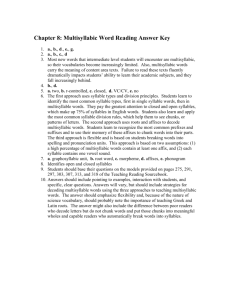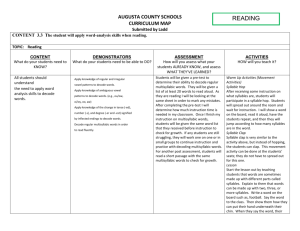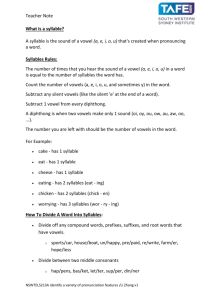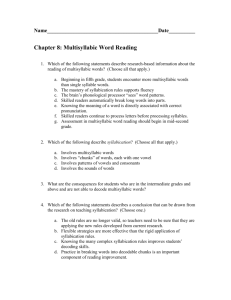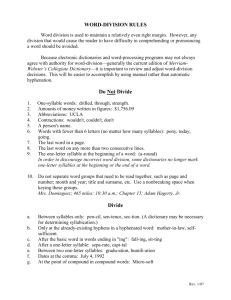Syllasearch
advertisement
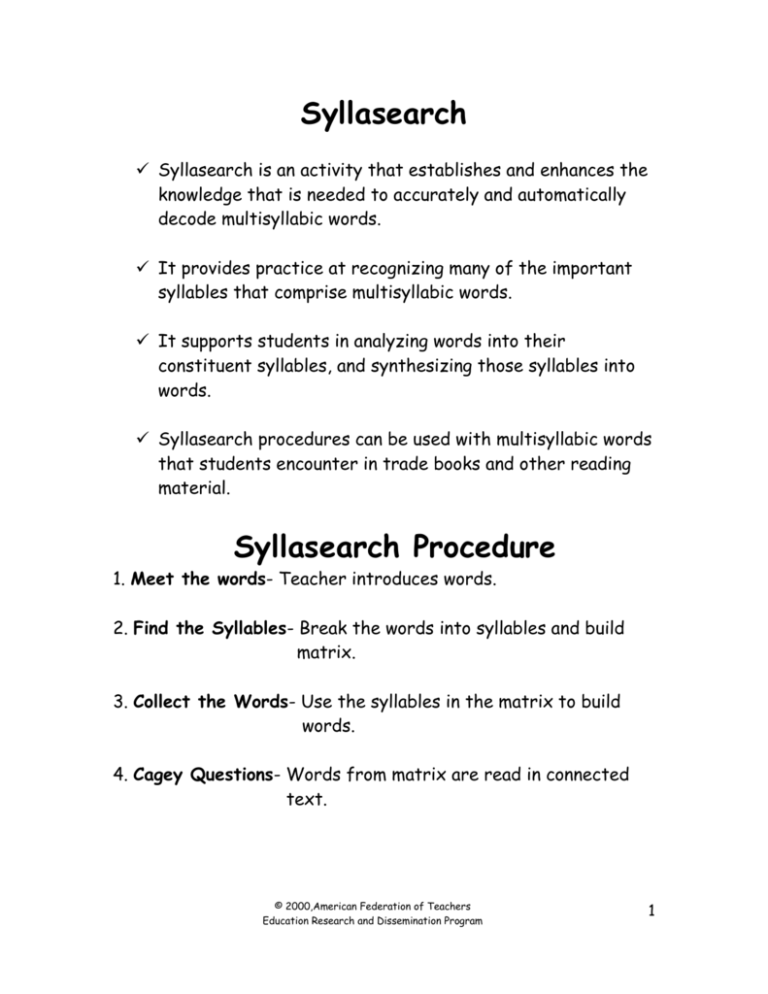
Syllasearch Syllasearch is an activity that establishes and enhances the knowledge that is needed to accurately and automatically decode multisyllabic words. It provides practice at recognizing many of the important syllables that comprise multisyllabic words. It supports students in analyzing words into their constituent syllables, and synthesizing those syllables into words. Syllasearch procedures can be used with multisyllabic words that students encounter in trade books and other reading material. Syllasearch Procedure 1. Meet the words- Teacher introduces words. 2. Find the Syllables- Break the words into syllables and build matrix. 3. Collect the Words- Use the syllables in the matrix to build words. 4. Cagey Questions- Words from matrix are read in connected text. © 2000,American Federation of Teachers Education Research and Dissemination Program 1 Syllasearch The purpose of Syllasearch is to support students’ development of multisyllabic word decoding. It does so by providing students with opportunities to analyze words into their constituent syllables and to synthesize those syllables into words. The words and syllables below are from the MEDIUM LIST- SET 4. of the SYLLASEARCH WORDS AND SYLLABLE LIST They are used as examples in the procedures that follow. The procedures can be applied to any multisyllabic words. MEDIUM LIST- SET 4 WORDS center market marvel marvelous marshal marmalade brisket chapter SYLLABLE MATRIX cen mar bris chap ket ter vel shal ma ous lade Tell students that the game they are going to play, Syllasearch, will help them read long words (multisyllabic words) fast and easily. Explain that Syllasearch has three parts. In the first part, Meet the Words, the students will become acquainted with a set of words. This means that you will read the words aloud and the students can read along with you. In the second part, Find the Syllables, students find syllables within the words and the matrix is built. Those syllables become the parts that students use to make words in the third part of the game. The third part, Collect the Words, has two versions, both of which will be described. © 2000,American Federation of Teachers Education Research and Dissemination Program 2 Meet the Words: Display the complete set of words in a column in a pocket chart or on the white board. Tell students that these are the words that they will use in the game. Go down the column, pointing to each word, reading it aloud. IF there are any words that you think the students may not have heard of, you may use the word in a brief sentence or give a student friendly definition for the word. For example, “Marvel. If you marvel at something, you express your great surprise or admiration. Her fellow members marveled at her seemingly infinite energy.” DO NOT BELABOR THE MEANING OF THE WORDS. THIS IS NOT A VOCABULARY LESSON. Assure students that if some of the words are unfamiliar now, it is all right because the game will help everyone learn them. Stress that an important first step in learning the words is to both hear them and say them. Read the words aloud again, encouraging students to say them with you. Keep Meet the Words brief and fast paced. At another time you might want to come back and deal with the meanings or other aspects of the words in more depth. But as the introductory phase of Syllasearch, Meet the Words is only to provide the students with a context of a “set” of words that they will deal with in a particular game of Syllasearch. Before beginning the next phase, Find the Syllables, remove the complete set of words. Find the Syllables: Place the first word in the list you have selected in the pocket chart and pronounce it somewhat deliberately, asking the students to say it with you. “This word is center. Read it with me, center.” With the word still in the pocket chart, invite a student up to name the letters in the syllable and articulate the sound the syllable makes. This is repeated for each syllable. © 2000,American Federation of Teachers Education Research and Dissemination Program 3 “What letters make the cen sound in the center?” (c-e-n) “What sound do the letters c-e-n make in center?” /cen/ “What letters make the ter sound in center?” (t-e-r) “What sound do the letters t-e-r make in center?” /ter/ As the student names the letters in the syllable and articulates the sound the syllable makes, put the corresponding syllable card in the pocket chart, arranging the cards in a matrix identical to the one on the Syllable Matrix for that set of words. Continue in this way until all the words in the list have been shown and pronounced, and all the syllable cards are arranged in the matrix. For example, the syllable card ‘cen’ should appear at the top of the first column of the matrix. The syllable card ‘ter’ should appear in the second column, second row. (See matrix below) NOTE: An easy way to keep track of where the syllable cards go is to put a small code in the corner of each card. You could code your columns with letter name and each of your rows with numbers. The first column would be A, the second B and so on. The first row would be 1, the second row 2 and so on. For example, on the ‘cen’ card you would mark ‘A1’ in the corner and the ‘ter’ card would be marked ‘B2’. Use a pocket chart to hold the cards when building the matrix. A pocket chart allows the syllable cards to be easily and repeatedly removed and replaced. You will notice that syllables are repeated in several words. Once a syllable has been put in the matrix and it comes up again in another word, just tell the students that the syllable is already in the matrix. You may ask the student to point to it in the matrix. cen mar bris chap ket ter vel shal ma ous lade Tell the students that they now have all the parts of the words and are ready to go on to the part of Syllasearch called Collect the Words. © 2000,American Federation of Teachers Education Research and Dissemination Program 4 Collect the Words: In this part of the game, students collect words by combining syllables from the matrix columns. There are two versions for Collect the Words. VERSION 1: Ask the students to look at the matrix and listen to the word that you say. After you say the word, invite a student to come to the chart and build the word. You can start with any word on the list, but only say the word, you do not show the word. “Listen to the word I say, marvelous…marvelous.” Invite a student to come to the chart to build the word. The student should pull away one syllable from each column to build the word, placing the syllable cards below the matrix to form the word. So the display would look like the following: cen ket ter lade bris chap shal ma marvelous Have the students read the word that was built from the syllables, and return each of the syllable cards in the word to their place in the matrix. Students can write the word, as you write the word on the whiteboard or put the completed word card (not the syllables that make the word) at the far right of the pocket chart, so that the display looks like the following: cen mar bris chap ket ter vel shal ma ous lade marvelous © 2000,American Federation of Teachers Education Research and Dissemination Program 5 Continue in this same way until all the words have been built, pronounced, and written. At the completion of this version of Collect the Words, the final display should look as follows, with the exception that the list of words can be in any order. cen mar bris chap ket ter vel shal ma ous lade center market marvel marvelous marshal marmalade brisket chapter VERSION 2: This version starts with the matrix. The difference is that instead of you telling the students what word to make, as in Item 1 above, call on a student to come and make any word he/she likes, noting that there are eight real words that can be made. When a word is made, write that word on the whiteboard, or place it in the pocket chart as a way of keeping track of which of the words have built. OTHER WAYS OF PRACTICING 1. Have the students make their own set of syllable cards with index cards and markers. -Using the matrix on the board as a model, students can arrange the cards in the same formation on their desks, and try to build the eight words. They can check their success with the list of words they wrote in Version 1. -Working in pairs, ask the students to make some words with the syllables, both real and nonsense words, pronounce them to their partners, and then write them. 2. There are a variety of game-like “overlays” that can be applied to Syllasearch, such as keeping track of how fast a student or pair of students can build all eight words, etc. The important point is repeated practice of finding the syllables (analysis of words) and then © 2000,American Federation of Teachers Education Research and Dissemination Program 6 collecting the words (synthesis of words) will help students tackle new multisyllabic words. It is important, however, that the repeated practices be fun. If they get boring and too pedantic they lose their power. 3. Teachers have found it useful to develop sets of words and syllables for multisyllabic words that students will encounter in trade books and other materials that they will read. When creating these sets, check dictionary.com for correct syllable division. When creating the matrix, be sure that no two syllables that follow each other in a word are presented side by side in the matrix. _______________________Cut Here ___________________________ Read the word… Say it with me…. What letters make the _______ sound? What sound do the letters _____ make? © 2000,American Federation of Teachers Education Research and Dissemination Program 7 SYLLASEARCH A Decoding Strategy © 2000,American Federation of Teachers Education Research and Dissemination Program 8


